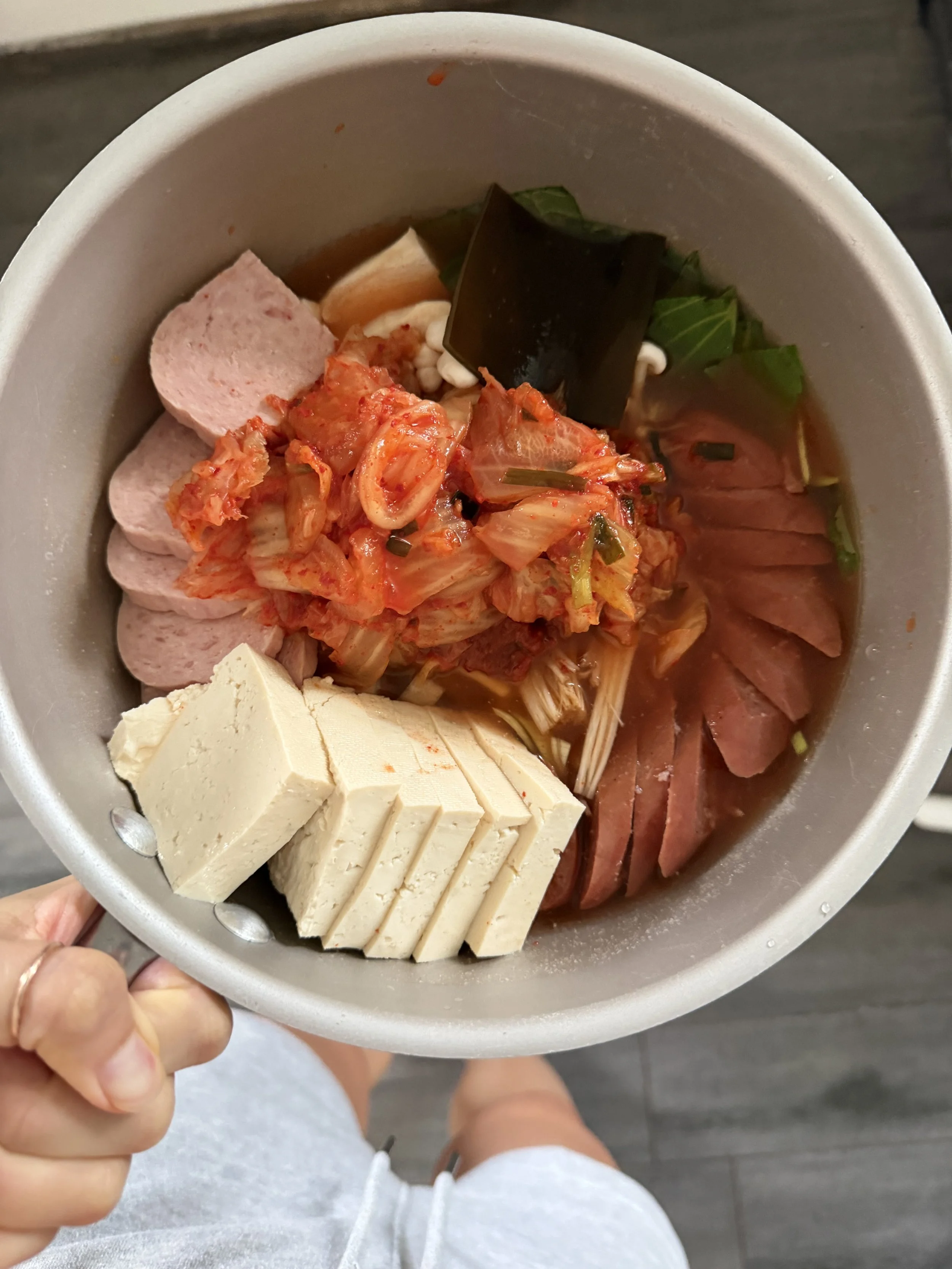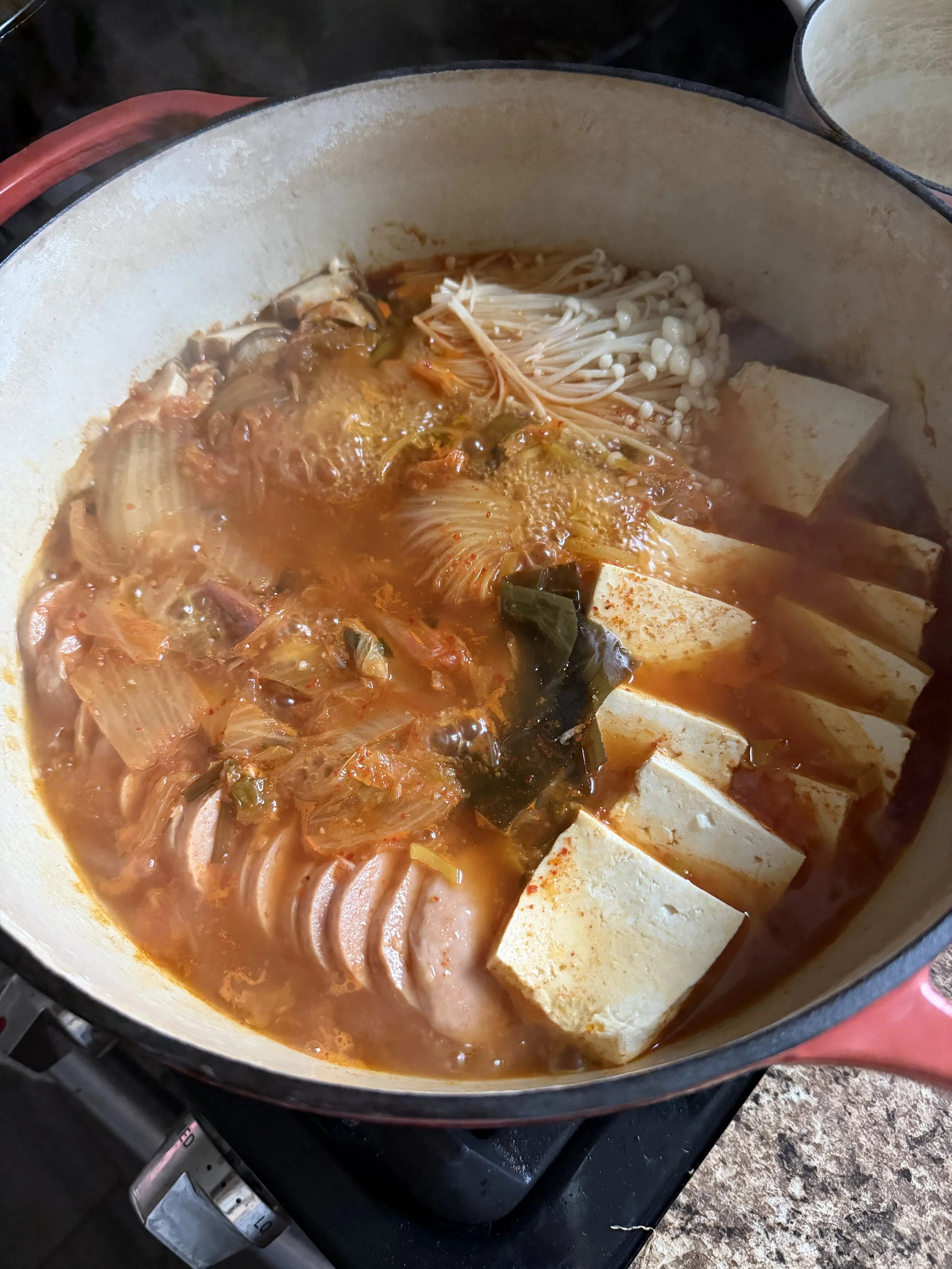🇰🇷 Budae Jjigae (Korean Army Stew) from Scratch | Comfort Food with Spam, Sausage & Kimchi
This gut-healthier version of budae jjigae (Korean Army Stew) keeps all the nostalgic comfort — Spam, ramen noodles, and that signature umami broth — while nourishing the body and honoring the brave souls who inspired it. Born from post-war resilience, this Korean-American fusion dish carries deep history and heartfelt gratitude. Happy Veterans Day — don’t forget to thank a veteran ♡
The ultimate Korean comfort food — spicy, savory, and hearty. Made “healthier” (;
Budae jjigae (Army Stew) blends Korean flavors like gochujang and kimchi with Western ingredients like Spam, cheese, and sausage for a dish that honors both cultures. This version skips processed soup bases and builds an incredibly soothing flavor that hits home.
🌶️ History of Budae Jjigae (부대찌개)
Literal meaning:
“Budae” (부대) = Army base
“Jjigae” (찌개) = Stew
Origins:
After the Korean War (1950–1953), Korea was struggling — food was extremely scarce, the economy was shattered, and people were trying to survive. Near the U.S. military bases, local Koreans traded for food from the bases. Think: Spam, hot dogs, canned beans, processed cheese.
These were unfamiliar, “foreign” ingredients at the time — but scrappy Koreans combined them with traditional staples like gochujang (red chili paste), kimchi, tofu, and local vegetables. The result: budae jjigae — a spicy stew that blends American military rations with Korean flavors. Genius.
Initially, it was a makeshift meal of necessity. Over time, it has became a beloved comfort food — to me, it’s a symbol of resilience, adaptation, hope, and the blending of two cultures that met under life & world-changing circumstances.
Why I’m making this soup for Veteran’s Day — there’s something healing about it — it’s origins are humble and born when my motherland (S. Korea) was war torn, yet it’s become something that brings people together and deeply soothes the souls of those who return home from their service in Korea & America.
Tap here to make it with me & my 5 yr old for our favorite Veteran.
🥘 INGREDIENTS (Serves 5-6)
Broth Base
5-6 cups anchovy stock
1 tbsp gochujang (Korean red chili paste)
1 tbsp gochugaru (Korean red chili flakes) - adjust to heat preference
1 tbsp coconut aminos
2 tsp minced garlic
2 tbsp kimchi juice (optional but adds depth)
Main Ingredients
1 can Spam, sliced into bite-sized rectangles
4 Teton’s grass fed sausage
1 cup ripe/aged kimchi, chopped
1/2 onion, sliced
1 stalk leek, chopped
1 block firm tofu, sliced
1 pack Korean instant ramen noodles
1 bundle enoki mushrooms
Optional Add-In’s:
1 slice raw or American cheese (to top before serving)
1 cup rice cake slices (tteok)
1 jalapeno, sliced
METHOD
1. Prep the Broth
In a small pot, simmer anchovy stock (or dashi)
2. Layer the Stew
In a large pot, arrange Spam, sausages, leeks, onions, tofu, and mushrooms around the pot in sections.
Place the gochujang, gochugaru, coconut aminos, garlic, and kimchi in the center.
Pour the broth over everything. Aim to have ingredients almost submerged.
(Feel free to add a splash of water to make sure it’s almost submerged)
3. Simmer
Cover and simmer over medium heat for 10-15 minutes, until the flavors meld. Stir until gochujang fully dissolves.
This is when you would soak/submerge your (optional) rice cakes in a bowl of filtered water if they are frozen (10-15 minutes)
4. Add Ramen & Cheese (& Optional Rice Cakes)
Add instant ramen noodles & rice cakes (tteok) directly into the bubbling stew.
Cook for 2–3 minutes until the noodles / tteok are tender.
Top with a slice of cheese and a slices of japalenos (for spice lovers). Let the cheese melt slightly before serving.
6. Serve & Enjoy
Serve hot right from the pot! Family style (;
Tips & Variations
Add baked beans for a sweet-savory twist — a nod to U.S. Army origins.
Add cracked egg in the final minute for creaminess & extra protein.
For spice lovers: top with extra gochugaru or sliced jalapeños.
For a milder stew: reduce gochujang to ½ tbsp and skip gochugaru.
Why This Version is Special
Apart from being my favorite Veteran’s favorite Korean dish, it is:
Soy-free (using coconut aminos) for hormone-healthy & allergy-friendly cooking.
Balanced (sweet & spicy) for a rich Korean flavor without any processed sugars.
Made from scratch — no MSG soup packets / gut disrupting pastes here!
A LEGIT fusion of Korean heritage + American comfort food.
If it’s your first time making this dish, don’t be nervous - the beauty of budae jjigae: it’s forgiving, hearty, and meant to bring comfort more than perfection.
Don’t forget to thank a Veteran for his/her sacrifice & service today ♡




